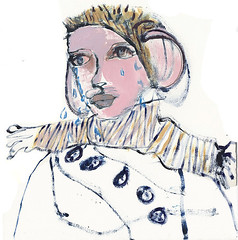
如果把这个问题改成:人类和猩猩的区别有多大?可能会更符合我们的认识逻辑。不过在你知道了这些信息之后,可能会提出相同的疑问:人类的基因有30%和香蕉相同,和果蝇则有更多的相同部分,而人类与老鼠的基因重复部分比起两者都多。基因有如此多的重复,却形成截然不同的生物体,那么人类和老鼠的区别有多大?-psytopic.com
你知道吗?人类的基因有30%与香蕉一样,更多的与果蝇相同,而与老鼠重复的则比二者都多。为什么基因有如此多的重复,却形成截然不同的生物体呢?在近期PLos(公共科学图书馆)期刊所刊登的一篇论文中,剑桥大学Pat Simpson及同事利用果蝇找到了初步的答案。
基因由两部分组成,一部分用于蛋白质编码(在不同的生物体中都是相似的),另外一部分控制基因何时、何地、以何种程度开启。
对于外行人来说,果蝇看起来都很相似,但是实际上,果蝇有近4000个截然不同的种类,这些种类的很多特征,如翅膀的纹理以及胸部硬毛的位置等有明显的差别,而这都是从始祖果蝇开始,经历了几百万年的进化而来的。每个物种——人类、老鼠(甚至香蕉)——都具有独一无二的形态,这与基因的微妙差别有关,但是这些差别位于基因的什么部位呢?
Simpson等人比较了两个种类接近的果蝇的基因,其中一种果蝇胸部具有两行硬毛,另一种具有四行硬毛。结果发现,差异就在于控制基因的一个很小的片断。如果交换这个基因片断,那么两行硬毛果蝇可以变成四行硬毛果蝇。
研究结果表明,控制基因的细微变化可以导致有机体的细微变化,经过不断的累积,就可能产生新的物种。尽管这已被进化生物学家广泛接受,但是目前缺乏由控制基因直接导致形态差异的实例。尽管不能通过调整基因序列将一个人变为一个香蕉,甚至是老鼠,但是对这些序列的研究有助于我们了解不同生物体的进化过程。
附原文阅读:
What's The Difference Between Mice And Men?
It's often said that a man shares 30% of his genes with a banana, rather more with a fruit fly, and yet more with a mouse; so why are these organisms so different if many of their genes are so similar? In a recent issue of PLoS Biology, Pat Simpson and her colleagues for Cambridge University use fruit flies to shed some light on the problem.
Genes have two parts: a bit that codes for proteins (this part is similar in different organisms) and a part that regulates the gene, which determines when, where, and how strongly the genes are turned on.
To the layman, one fruit fly looks much like another, but there are, in fact, nearly 4,000 distinct species differing in characteristics such as the pattern of veins on the wings or the position of bristles on the thorax. These differences have evolved over millions of years, since the first ancestral fruit fly arose--and it's not just flies. Every species--man, mouse (and bananas)--has evolved a unique form, correlated with subtle differences in their genes, but where in the genes do these subtle differences lie? By comparing genes between two closely related species of flies, one with two rows of bristles on the thorax and one with four rows, these workers homed in on a short part of the control region of one particular gene that appeared to be different. By swapping the bit around, they could turn a two rows fly into a four rows fly.
These results show that slight changes in the control regions of genes lead to slight changes in the organism, and accumulation of such small differences may result in the creation of a new species. While this is widely accepted by evolutionary biologists, actual examples directly linking small changes in regulatory parts of genes to morphological differences have been scarce. While it may not be possible to swap regulatory sequences to turn a man into a banana, or even into a mouse, examination of these sequences may tell us how different organisms evolved.
Source: sciencedaily.com
Psytopic摘自《三思科学》/原文链接
No comments:
Post a Comment